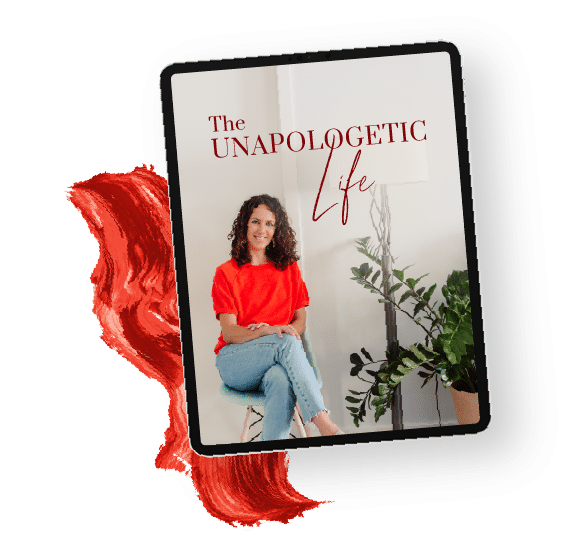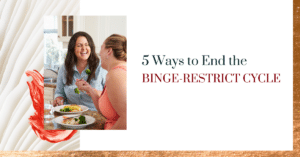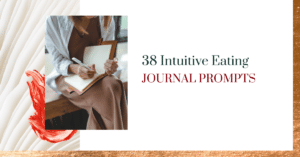Eating for Fullness vs. Satisfaction – What’s the Difference?

It is common to think that knowing how much to eat is about focusing on how full you feel and how to stop eating when you feel that fullness. In reality, though, eating an amount that works well for your body is less about learning to feel your fullness and more about ensuring you’re not getting too hungry or depriving yourself. Finding a place of comfortable fullness comes naturally when your body stops feeling deprived. Beyond this, if we tune into satisfaction, we are much more likely to eat until we feel adequately nourished rather than uncomfortably full. Read on for the difference between fullness vs satisfaction and why satisfaction is known as the “hub” of intuitive eating.
To dive more deeply into these ideas, take a look at my book Unapologetic Eating: Make Peace with Food and Transform Your Life.

The Difference Between Fullness and Satisfaction
It’s possible and even common to feel full without feeling satisfied. Say, for example, you were to eat a large bowl of raw vegetables or a meal of baked chicken, brown rice, and sautéed spinach that you thought you should be eating but weren’t actually interested in eating. Afterward, your stomach may feel physically full, but you probably would not feel satisfied. When you aren’t satisfied, you will often continue to eat more food or fantasize about certain foods in search of that feeling of satisfaction, even if you aren’t hungry.
As Rachael Hartley, a fellow registered dietitian, explains: “Fullness is the physical sensation of satiety, while satisfaction is the mental sensation of satiety.”
Satisfaction is the hub of intuitive eating. If you aren’t happy or satisfied with the foods you are eating, it’s hard to develop a healthy relationship with food. It’s important to find the pleasure associated with food in order to feel satisfied and content. You’ll find that the more pleasure you get from food, the easier it is to eat to a place of comfortable fullness and not think about food all of the time.
Satisfaction is a better indicator than fullness for deciding when your body is ready to stop eating.
This is why it’s important to think not only about what foods make you feel full, but what foods bring you pleasure and satisfaction as well. It may be hard to figure out what foods are most satisfying to you, especially if you’ve been dieting for a while or are used to following food rules. Diets tell you what to eat, which can make you overlook what your body actually wants to eat. But with some practice, you can figure out what foods give you the most pleasure, and it will become easier to enjoy your food and eat in a way that makes you feel good.
Finding ‘Comfortable’ Fullness
When you restrict the amounts or types of foods you are eating, your body goes into starvation mode. Even if you are eating “enough” food, if you aren’t letting yourself eat certain foods or types of foods, your body thinks you are in a time of scarcity. It is seeking satisfaction that would only be found from eating the foods you are not allowing yourself to have. You may therefore eat to a point of uncomfortable fullness during meal and snack times so you can “survive” that time of scarcity. You may also have the tendency to feel out of control when eating the forbidden or restricted foods.
Once you stop restricting food types or quantities, it takes some time for your body to readjust. If those foods or those amounts weren’t allowed for a long time, there will be a period of eating to a point of uncomfortable fullness until your body becomes used to having those foods around. Once those foods lose their power as the “forbidden foods,” you will naturally begin to stop eating when you are comfortably full much of the time, because your body knows you can have that food again whenever you would like.
Eating to a point of comfortable fullness actually has less to do with “making” yourself stop eating when you’re full and more to do with ensuring you are no longer feeling deprived.
So rather than focusing on not “overeating,” try shifting your focus to eating foods you enjoy and not depriving yourself, and, in time, you will be amazed at how natural it becomes to pay attention to and follow your fullness.
How to Build A Satisfying Meal
Follow these two steps to find that sweet spot between fullness and satisfaction.
1. Ask yourself “what foods do I enjoy the taste of?”
For a food to be satisfying, it needs to taste good.
- Make a list of foods that you enjoy eating, whether that is the taste, the texture, the smell, etc. The foods that are satisfying to you may change from day to day or even meal to meal.
- Before each meal, take a moment to pause and think about what food sounds good to you at that moment in time. If you’ve been dieting for awhile or are used to following food rules, this may be hard at first. Play around with it and take note of how satisfied (or unsatisfied) you feel after eating different foods.
For example, one of my clients realized that hot foods at breakfast satisfy her way more than cold foods. She would be just as full if she ate a yogurt bowl, but she wouldn’t feel satisfied. Once she realized this and started eating hot meals like eggs or breakfast sandwiches, she was able to stay full and satisfied for much longer.
2. Include carbohydrate, protein and fat.
These three nutrients signal fullness by releasing hunger-suppressing hormones and raising your blood sugar. While it’s possible to fill up your stomach with low calorie/high volume foods (going back to that huge bowl of vegetables), without protein, fat or carbohydrates, your body won’t feel satisfied.
If you’re interested in better understanding your feelings of satisfaction and fullness, try some of the below tips:
1. Reduce distractions during mealtimes. Trying some meals without technology at hand can help you pay better attention to the meal itself and your enjoyment of it.
2. Eat mindfully. Try eating some meals where you take time to savor the food you are eating. Pay attention to how it looks, smells, feels and tastes.
3. Take a pause. Fullness is regulated by the hypothalamus in the brain. When your body has enough food to meet its needs, signals are sent to the hypothalamus. But it takes some time for those signals to travel to the brain. If you pause halfway through your meal, it will take you off autopilot so you can check in.
4. Try the hunger-fullness scale. One tool that can help you tune into your body’s more subtle feelings is the Hunger-Fullness Scale.
5. Don’t be afraid to leave leftovers. Dieting causes us to feel like we “have” to eat at meal times – when it is allowed – so leaving food behind can be difficult. On top of that, many of us were raised with the “clean plate” mentality. If you’re afraid of wasting food, give yourself permission to put food away for later if you’re feeling “done” eating.
In time, you will naturally eat the amount of food your body needs. This amount changes from day to day based on multiple factors, including how active you are, how much sleep you got last night, how much stress you’re under, and even what you ate the day before.
Can you think of some foods that fill you up, but aren’t satisfying? Share below!
Are you interested in learning more about intuitive eating?
We work with clients virtually throughout the US, helping people who are frustrated with dieting change their relationship with food and say goodbye to diets once and for all. Learn more about our intuitive eating coaching programs to see how you can find balance and develop long-term lifestyle habits, no diets required.
Not ready for one-on-one coaching or looking to learn more about intuitive eating on your own? Check out Unapologetic Eating 101 , a self-paced online course that walks you through the foundational principles of intuitive eating, and food and body liberation.
This post was updated with support from Autumn Rauchwerk (@autumnrosewellness), a Dietetic Intern and Registered Yoga Teacher based out of Brooklyn, NY.
Author Bio
This article was written and reviewed by Alissa Rumsey, MS, RD, CSCS, a registered dietitian and Certified Intuitive Eating Counselor. She specializes in weight-inclusive care, intuitive eating, body image healing, mindfulness, self-compassion, and healing from chronic dieting, disordered eating, and eating disorders. Alissa holds a Bachelor’s Degree in Nutrition and Exercise Science, and a Master’s Degree in Health Communications, and is also an NSCA Certified Strength and Conditioning Specialist.
30 Comments
Leave a Comment
share the love

about
Alissa Rumsey, RD.
Alissa Rumsey, MS, RD, CDN, CSCS (pronouns she/her/hers) is a registered
dietitian, nutrition therapist, certified intuitive eating counselor, and the author of
Unapologetic Eating: Make Peace With Food and Transform Your Life. Alissa is
passionate about helping people reclaim the space to eat and live,
unapologetically.

A twice-a-month round-up of inspirational stories, lessons, practical tips and encouragement for living your most authentic, unapologetic life.
The Unapologetic Life
RECENT POSTS

The Unapologetic Life
A twice-a-month round-up of inspirational stories, lessons, practical tips and encouragement for living your most authentic, unapologetic life.











Loved this article. Just today a I was pondering over feeling full v/s satisfied, this has cleared out a lot of doubts I had. Thank you Alissa 🙂
Thanks for the feedback Vidhi, happy to hear you found it helpful and timely 🙂
When I go to dinner I feel fuller sooner because I am satisfied with what I’ve chosen to eat. Good article.
Great point Jane! Thanks for sharing 🙂
Oatmeal with a scoop of peanut butter makes me feel so satisfied in the mornings. I can make it to lunch when I eat it! But toast and peanut butter leaves me wanting more. I am not sure why one is so much more satisfying to me than the other!
It’s hard to know with certainty why some meals fill us up and others don’t, but it can change from day to day and meal to meal. I always try to employ curiosity instead of judgment, and see if you can think of what makes one more satisfying and filling than the other.
I’m incorporating all sorts of carbs that I’ve denied myself for a long time. Carbs that I labelled “harmful for my health” hence “a treat for myself”, but only every other weekend or once a month.
I had oats with berries and peanut butter for breakfast, rice as a main for lunch and steak with a side of sweet potatoes for dinner.
I felt satiated and satisfied. And happy.
I finally realised how much deprivation I welcomed in my life over the years to maintain a slimmer body.
I’m turning 30 this year. I had enough of this negative self image and diet crap.
That’s wonderful, thanks so much for sharing Alice!
After years of dieting, someone finally said it correctly. Thank you! Without satisfaction, dieting won’t work. Just this last week I decided I needed to include foods I enjoy, but may not be included on certain popular diets. However, I monitor the amount. Sometimes two bites, eaten slowly, of something sweet is enough.,especially if I wait 15 or 20 minutes after those two bites. Once those two bites are through my system, I realize I’m satisfied!
After I ate lunch today I realized I wasn’t hungry but felt unsatisfied, which is how I ended up on your site. I hated this feeling because it often leads me to overeating. As I munched on the chips I bought after eating I realized my lunch lacked crunch. I had a fat, a carb, protein and veggies but nothing had crunch. I had already drank 60 oz of water so I don’t think I was dehydrated. I wonder if when I meal prep I should pay attention to the texture of my food?
Great awareness here Melissa! Yes, food satisfaction comes not jsut from the presence of carb/protein/fat but also from taste, texture, temperature, even smell of food! If you notice that texture is a satisfying thing for you then yes, this is a great thing to pay attention to when thinking about when putting together your meals.
This is incredibly helpful! I often get strong binge cravings and feel hungry even after overeating. Looking back, there was usually something disappointing about the meal. Like maybe I craved fresh, seeded, whole grain baguette dipped in tomato sauce but they only had stale, bland, white bread. I am excited to explore this concept further and see if I am satisfying myself equally as often as i am filling up my belly! Thank you for the article and it’s also cool reading other people’s comments! Texture is a great idea!!!
it’s really helpful. thank you so much
Wow this article was so helpful. I just finished eating a bowl of veggies and feel full, but completely unsatisfied. I googled the why and your article came up. Thank you for the information. I’m going to practice mindful “full & satisfying” eating.
Thanks for sharing Gabrielle, I’m so happy it was helpful!
Love this article! You hit the nail on the head! Now I will be so much more conscious of what I am eating. Thank you! Thank you! Thank you!
I’ve been dating nachos for a long time. Today, though… I advanced at least 13 levels in nacho satisfaction. I wanted them. I ate slowly and mindfully, paying attention to the crunch, the cheese, the guac, and the perfect carnitas. And I stopped eating when I was content and satisfied. I closed the takeout box, even though it was still 47% occupied. 10/10 for this eating experience. All joy, no guilt, no shame, and I even still love myself. And nachos.
This makes a lot of sense. Thanksgiving my aunt fixed everyone’s plate (to limit contact) and she put such large portions that I would never fix for myself. To my surprise I was able to finish all of it and could still eat more. The texture of most of the foods were soft I think that may be why I was able to eat so much and still want more.
Thank you for the great insight.
I had been eating huge quantities of vegetables because they were required on the food plan I was on. There was very little in my “allowed” foods that I really loved, and so I rarely looked forward to my meals….just the binges in between, and even then, I sometimes deprived myself of what I really loved — just buying cheap convenience store brands. I am changing that now and I am beginning to feel an incredible freedom and joy with my meals!
That’s fantastic, thanks so much for sharing Mary!
Really thought-provoking. Over the last couple years I moved from diet/restrict at a severe level to a “clean eating” approach. And while this was probably a bit better nutritionally I have still noticed that even though I was very compliant I was often unsatisfied and would go graze after eating, and not often for things that my “clean coaches ” would have been happy with. The idea if trusting myself with what, when and how much is a little scary, TBH. I’m willing to explore and be curious, though, and just see what there is to learn.
Hi Kate, it’s totally normal for this approach/idea to feel scary – we are taught (often from a young age) in SO many ways that we can’t trust our body (which not only isn’t true, but just erodes our inherent body trust even more!). Thanks so much for sharing your thoughts, glad you found it thought-provoking – curiosity is a great way to begin this journey 🙂
This was a great read I have been dieting most of my life mainly carb restrictions then I loose totally control and over eat then I start again every time I try to let myself have carbs even healthy ones I binge eat
I do want to eat normally and what u are saying makes so much sense but I’m scared to eat normally as I don’t want to put on the weight
I know I need to try and trust myself
Hi Zoe, it can be really scary to lean into the unknown – and something that is the opposite of what you’ve been taught! But this is where the healing is, sitting with the discomfort that the unknown brings up and trying something new. Any restriction usually ends up causing binging/feeling out of control around that food, it’s the letting go of restriction and giving ourselves permission to eat that is how we heal. The fear of weight gain can be another form of restriction, so may keep you in the restrict-binge cycle – I’d recommend working with a dietitian and/or therapist who specializes in body image/intuitive eating, they can help you work through this fear and get out of the cycle.
I’ve read tons about feeling hungry over the years but never as it related to satiety. Lightbulb moment. This is huge and really helpful! Thanks so much.
You’re so welcome, I’m so glad it was helpful!
This article is what I need. I struggle with eating disorder ever since I was 15, and I am now slowly recovering and this article was really helpful thank you ?
You’re so welcome Robin, I’m glad you found it helpful! Best of luck with your recovery.
I am trying intermittent fasting, and finding that at the allowed times, I am eating to the point of feeling over-full. the line about difficulty leaving food behind resonated a lot!
Thank you so much for sharing! It seems like your body might be driving you to eat past the point of comfortable fullness because it is interpreting your fasting periods as those of scarcity, and it is trying to overcompensate to prepare you to “survive” that “starvation” period. Our bodies don’t differentiate between intentional fasting (such as with IF) and unintentional fasting (such as in a time of food shortages); they see the lack of food in either case as a sign of danger. One of the ways we can communicate with our bodies that we’re actually safe is by eating enough, and eating consistently. I’m glad the tip about being open-minded about leftovers is resonating with you! I hope the other tips discussed here can help you enjoy your meals a bit more and avoid uncomfortable fullness moving forward.